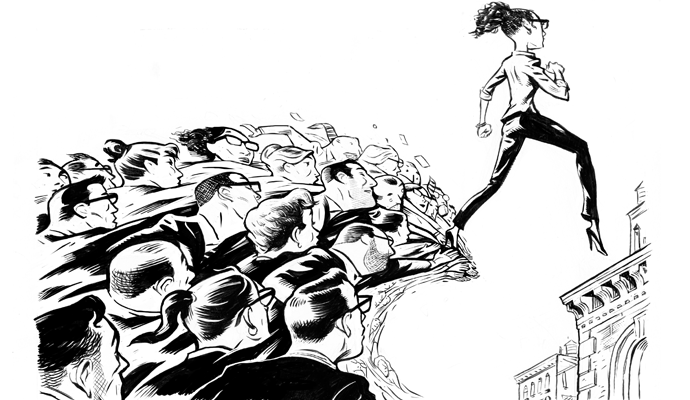The Three Measures of Your Leadership Success
Assessing your effectiveness requires looking simultaneously at the past, the present, and the future.
Are you a successful leader? This is a difficult question to answer: No matter how good you think you are, the only evidence of leadership is whether people follow you. Self-serving bias distorts your perception of your own successes and failures. Even if you’re incredibly self-aware, you may have trouble with an objective assessment because your direct reports may only appear to be following — they don’t get an option to be physically present — and not every company conducts rigorous engagement surveys or 360-degree reviews.
So how can you gain a reasonably accurate understanding of your success as a leader? Try integrating three distinctive views.
The first is what could be called “the measure of now,” and although it gets the most attention, it may actually be the least revealing unless properly contextualized. Now is measured by your key performance indicators: Did you hit your numbers? Exceed your quarterly or annual goals? What’s the turnover rate among subordinates? The deeper question, of course, is what you did to achieve those right-now results. The best leaders meet short-term objectives while building long-term capacity and capabilities. Now is just a step toward a larger goal.
Unfortunately, some managers whittle away at mission and culture in order to feed the beast of now. I was speaking with a department head of a large regional professional services firm recently who lamented how a once-vibrant, mission-focused culture at her former company had become toxic as the partners sought to cut internal costs in order to fund other activities. “It was a great place for several years,” she said. “Then we were asked to squeeze more and more out of people. My best people left for other firms. Eventually, I did too.” That can be the trouble with now — if you aren’t mindful, it can suck the life out of tomorrow.
The second measure helps put now in perspective: looking forward. Where do you and your organization want to be in five, 10, or 20 years? In their 2006 book, Your Leadership Legacy, Robert M. Galford and Regina Fazio Maruca argued that leading well now requires an understanding of what you want your ultimate impact to be. Your legacy isn’t formed in the last six months or even six years of your career — it is an accumulation of all that you have done. It is never too early to begin thinking about the imprint you are leaving on the people you lead and those alongside whom you serve.
In my leadership teaching, I often use an exercise in which people are asked to describe someone they have known whom they consider to be a great leader. No Moses or Nelson Mandela — someone they have known through work, education, or community activities. The people they describe are individuals who had an enduring, positive influence on them. It is often noted that these people were not self-centered or interested only in their own careers. They invested time and energy in the development of their people. They helped them stretch and grow. They had high standards for accountability but also made sure that their people had the tools and resources needed to achieve the desired outcomes. One such person earlier in my career described his role as removing the obstacles to my success. These are individuals cultivating value, not simply extracting it.
The third measure reverses the telescope. This is the look backward over time. These are not the accolades given at your retirement party or when you’ve been lured away to a loftier position. Rather, this is an exercise in looking at the lasting value of what you did in your role. The true leader develops a strong team that carries on and continues to grow after he or she has departed. Performance that collapses after a single person is removed from the equation is fragile indeed.
Performance that collapses after a single person is removed from the equation is fragile indeed.
Look back to your last position. How have those who worked for you fared? If they have risen in the ranks — perhaps to assume your role — or were poached by other departments, you likely did well. If they are still in touch with you, it shows that your impact is enduring. Are your cultural norms still in place and being built upon? That is another sign that you were a successful leader. Retired U.S. Navy Captain David Marquet makes this point well in his book Turn the Ship Around Marquet took a nuclear submarine from worst to first in the fleet in his first command. As gratifying as that was, Marquet took his greatest satisfaction from seeing the ongoing success of his ship and its crew well after he had moved on.
I’ve met Marquet, and it is fascinating how his approach integrated these three perspectives of now, forward, and backward. Like many leaders, he was measured on specific metrics at particular points in time. He met them in the now (knocked them out of the park, actually) by looking far forward to the potential of what his team could be and not taking too much credit until he saw the sustained success well after he had moved on.
When 2015 results are announced, there will be celebration for some and jeers for others. Remember that this is simply noise from those who see only the now. The true measure of your success as a leader requires a far more nuanced view. A single quarter or year is only one sentence in a far longer story.






